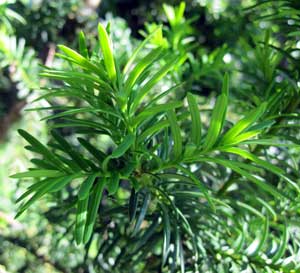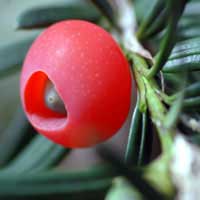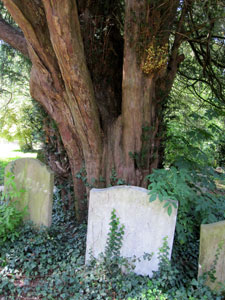The Yew

In the UK, there are three native conifers: the Juniper, the Scots Pine and the Yew (Taxus baccata). The genus Taxus contains some eight species, seven of which are found in the Northern Hemisphere.
The Yew is said to be slow growing and of great longevity. Some Yews (e.g. the Fortingall Yew in Argyllshire), are probably thousands of years old. Estimating the age of a Yew can be difficult as they develop hollow trunks; so dating by annual rings is next to impossible. These trunks may also fill with aerial roots that grow down from the crown.
Estimates suggest that when the tree is relatively young, it may increase in girth by about a foot every 30 years. So, a tree with a diameter of about 25 feet might be about 700 – 800 years old (see http://www.indigogroup.co.uk/edge/oldyews.htm). The girth of the Fortingall Yew was recorded as being some 56 feet in 1769 – so possibly how old?
 The Yew tree, which is dioecious (that is, it has male and female forms), takes some 70 years to bear flowers or fruit. Female trees are most readily recognised when they bear their red fruits. The outer part of the fruit is a red, fleshy cup or aril, which attracts birds. The aril is the only part of the plant that is non-toxic. Within the fleshy aril is a hard brown nut, which is distributed by birds (it passes through their digestive system).
The Yew tree, which is dioecious (that is, it has male and female forms), takes some 70 years to bear flowers or fruit. Female trees are most readily recognised when they bear their red fruits. The outer part of the fruit is a red, fleshy cup or aril, which attracts birds. The aril is the only part of the plant that is non-toxic. Within the fleshy aril is a hard brown nut, which is distributed by birds (it passes through their digestive system).
Because of the relatively slow growth of the tree, Yew was not planted in great numbers to form woodlands or plantations; though it has been used extensively as hedging. Millions of young yew trees have been planted in Yantai and Sichuan in China in the last few years to provide material for the extraction of the anti-cancer drug taxol/paclitaxel. The Yew that has been planted is a hybrid form - Taxus x media, which is thought to be a cross between T. baccata and T. cuspidata – the Japanese Yew.
For centuries, it was known that the seeds, leaves and bark of the Yew were poisonous to humans, cattle and horses so it is good that one of the chemicals is now being used as a phytomedicine to control/halt the proliferation of cancerous cells.
 Other than this modern use, the Yew has served many functions and purposes over the millennia. The earliest known use is as a thrusting spear from the Hoxnian inter-glacial period, which is many hundreds of thousands of years ago! The burial ship at Sutton Hoo contained a Yew bucket; and the wood was much favoured in Norman times for the making of long bows. Its use in bow making may pre-date this by some thousands of years as evidenced by the ‘Ice Man’ found in the Alps. It has been, and is still used, in furniture making and is much favoured by wood turners. Its water resistant qualities mean that it has been used for house foundations in places like Venice.
Other than this modern use, the Yew has served many functions and purposes over the millennia. The earliest known use is as a thrusting spear from the Hoxnian inter-glacial period, which is many hundreds of thousands of years ago! The burial ship at Sutton Hoo contained a Yew bucket; and the wood was much favoured in Norman times for the making of long bows. Its use in bow making may pre-date this by some thousands of years as evidenced by the ‘Ice Man’ found in the Alps. It has been, and is still used, in furniture making and is much favoured by wood turners. Its water resistant qualities mean that it has been used for house foundations in places like Venice.
Yew is to be found naturally on many soil types, though it is perhaps more common on chalk in the south east and limestone in the north. It is also found in the shade of oak woodlands, and during the last 300 years it has been widely planted in parks and gardens. Ancient or veteran trees are often associated with church-yards and have been connected with other sacred places.
Comments are closed for this post.
Discussion
[…] A varied group of plants, most are evergreen. Examples include the redwoods, pines, yew, juniper, spruces and larches. In some parts of the world, conifers form the dominant vegetation e.g. The Taiga. Conifers are important economically – softwood for timber and paper production. http://www.woodlands.co.uk/blog/trees/the-yew/ […]
I am interested in the view that plantations would be few as quite close to my home there is what can only be a Yew plantation, no idea how old it is but I would say that three of the trees have a girth of around 10 feet. The plantation is (now?) two trees wide by five deep it is possibly wider as there are mature Yews in adjoining properties that may well be part of the plantation but not obviously so all within a fifty yard by fifty yard area. There has been extensive development in terms of residential housing within the last thirty years including new access roads adjacent to the plantation so yews may have been lost.
[…] The bark and leaves of various yew species contain a chemical, paclitaxel, which offers hope as an anti-cancer drug. The bark of many trees (such as oak and sweet chestnut) is an excellent source of tannins, which […]
The Yew has long had associations with religion / immortality / longevity – for some background information see
http://www.the-tree.org.uk/BritishTrees/yew.htm#The%20Graveyard%20Tree,%20which%20can%20live%20'forever'%A0
http://www.whitedragon.org.uk/articles/yew.htm
http://www.history.uk.com/churches/index.php?archive=3
also Yews for the Millenium – see
http://www.arcworld.org/projects.asp?projectID=71
http://news.bbc.co.uk/1/hi/uk/551298.stm
I heard something the other day about a campaign to plant yews in churchyards to mark the Millenium (this was back in 2000 of course). Does anyone know why they are associated with churchyards?
There is an interesting post at the Ranger’s Blog on Yew Clippings
http://naturenet.net/blogs/index.php/2007/10/01/oi_yew_1
I donate some 400Kg of yew (taxus baccata) clippings per year to a company (clyst yew care) which they process and ship to france to extract the anicancer chemical taxol/paclitaxel which will treat about 20 cancer patients per year. This is a very worthy cause and more large and small gardens need to be aware of.
The aril is surprisingly sweet and juicy, a real autumn treat – but remember not to swallow the stone!

[…] berries but cones. Juniper is a conifer (the other two native coniferous trees are Scots Pine and Yew). Whereas the cone of Scots Pine hardens and become a woody structure as it ages, the cone of […]
Gin and Juniper | Woodlands.co.uk
29 January, 2014